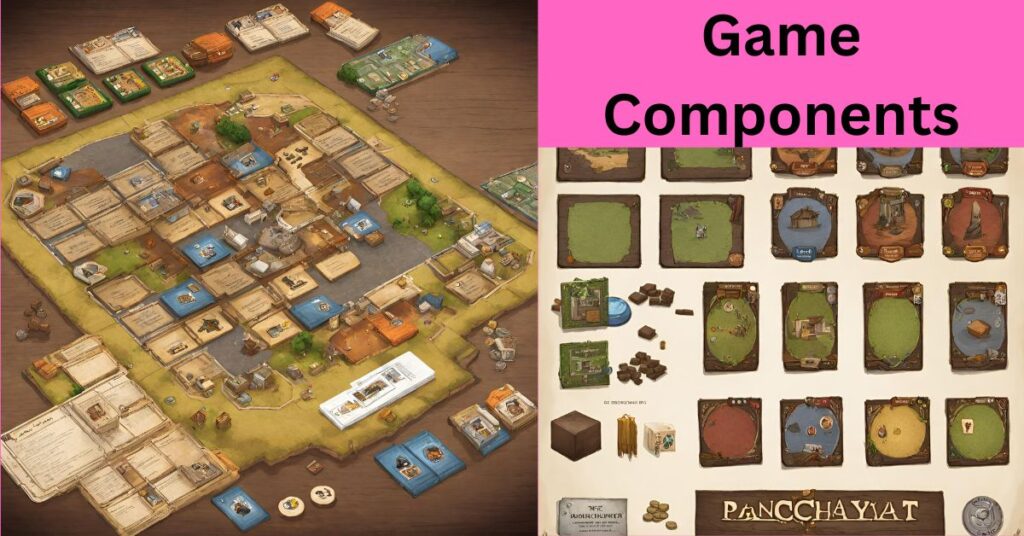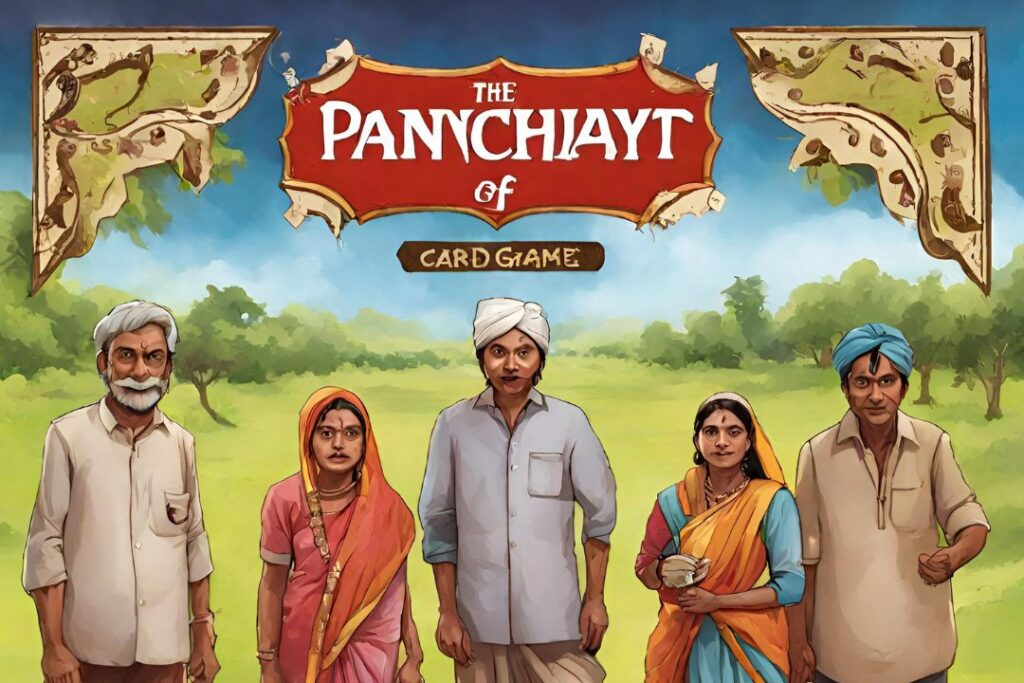Introduction
In today’s blog, we are going to explore the exciting Game of Panchayat. This game has been created by END Desa and published by K Games, offers an amazing tile placement experience for players. It revolves around creating a beautiful village and competing with other players to earn the most victory points.
In this game, players will race among themselves and try to make their village the best and If they become the best, they will get some winning points and if you place the right building at the right time, you will also get some bonus points which will eventually be achieved. The one who has the most victory points will win this game
Let’s research the details of this captivating game! So let’s start Panchayat.
Game Components of Game of Panchayat

The game of Panchayat comes with several components. The central feature is the score board, which is placed at the center of the table. Additionally, there are game bonus tiles, which players can earn at the end of the game. These tiles need to be placed face up below the board, while the remaining tiles are placed inside the game box and not used in the game. There are also solo player tiles, which include solo objective and solo jamaidar discard tiles. However, we will primarily focus on the game for three to four players in this blog.
Setting Up the Game

Before we begin the game, let’s take a look at the setup. The building tiles in Panchayat are categorized into general, commercial, residential, industrial, and utility buildings. To start the game, players need to create a deck by shuffling these tiles and placing two face-down decks. From the deck, players need to draw three tiles and place them face up in their village board. The remaining tiles are not used in the game. The player with the most recent visit to a rural area becomes the starting player. The game is played clockwise. Now, let’s explore how these building tiles are collected and placed in the village board.
Collecting Building Tiles
If you are playing with two players, you need to select tiles from the Cow Shade, Three House, and Immediate tiles. For example, you can choose three tiles from the Cow Shade and three tiles from the Immediate tiles, placing them in your village board. If you are playing with three to four players, you can use all the building tiles. After selecting the tiles, you should shuffle them thoroughly and create two face-down decks. From the top of the deck, each player needs to take three tiles and place them face up in their village board. These tiles should be arranged in a way that three tiles are on top and the remaining tiles are placed below.
Placing the Tiles
Now, let’s focus on how these tiles are placed on the village board. The New Building tiles are placed in the empty spaces of the Old Building tiles. For example, if you want to place a tile near the left top corner, you will have to place it adjacent to the existing tiles. However, the placement bonus points will only be received for the buildings placed near specific locations. The Village Center, located in the green area of the board, provides additional bonus points for placing specific tiles adjacent to it.
Understanding the Bonus Actions
In the game of Panchayat, certain tiles provide bonus actions. For instance, the Railway Station tile gives you three victory points if placed adjacent to the temple. However, placing it near the farm will result in a deduction of one point. Similarly, the Post Office tile provides an immediate action when placed on the village board. During the pick action, you can pick any top tile from the discard pile and place it. During the place action, you can pick any top tile from the discard pile and place it. The Post Office tile can only be used once per turn. These bonus actions can significantly impact your gameplay and strategy.
Utility Tiles
Utility tiles in Panchayat consist of two buildings: the Railway Station and the Post Office. Placing these tiles on the village board provides additional bonus actions. For example, placing the Railway Station tile adjacent to the temple grants you three victory points and an additional three points if the tile is placed in the green area. On the other hand, placing the Post Office tile adjacent to the farm gives you a bonus action, allowing you to move any tile on your village board once per turn. These utility tiles add depth and strategic decision-making to the game.
Conclusion
The game of Panchayat offers an engaging and strategic tile placement experience. By carefully selecting and placing the building tiles on the village board, players can earn victory points and compete to create the best village. The bonus actions provided by utility tiles further enhance the gameplay and add depth to the overall strategy. So gather your friends and family, and embark on an amazing journey to build the perfect village in Panchayat!
FAQS on Game of Panchayat
How many players can Game of Panchayat?
The Game of Panchayat can be played with 2, 3, or 4 players
How long does a game of Panchayat typically last?
A game of Panchayat typically lasts around 30-45 minutes.
What is the objective of the Game of Panchayat?
The objective of the game is to score the most victory points by strategically placing building tiles in your village board.
How do you earn victory points?
You earn victory points by placing building tiles near specific locations, such as the Village Center, farms, and other buildings. Some tiles also provide bonus points when placed adjacent to each other.
What are the different types of building tiles?
There are five types of building tiles: general, commercial, residential, industrial, and utility. Each type of tile has its own unique scoring rules and benefits.
What are bonus actions?
Certain tiles, like the Railway Station and Post Office, provide bonus actions when placed on the village board. These actions allow you to perform special moves, such as picking tiles from the discard pile or moving tiles on your board.
What are the different components of the Panchayat game?
The game includes a score board, game bonus tiles, solo player tiles (for solo play), building tiles, player boards, and resource tokens.
What are the solo player tiles used for?
The solo player tiles are used for playing the game in solo mode. They include solo objective tiles and solo jamaidar discard tiles.
What are the different types of bonus tiles?
There are three types of bonus tiles: placement bonus tiles, adjacency bonus tiles, and endgame bonus tiles. Each type of tile provides different scoring benefits.
How do you set up the game?
Shuffle the building tiles and create two face-down decks. Each player draws three tiles and places them face up in their village board. The remaining tiles are not used in the game.
How do you determine the starting player?
The player with the most recent visit to a rural area becomes the starting player.
What are some tips for winning the game?
Pay attention to the scoring rules and bonus point opportunities.
Plan your village layout in advance to maximize your scoring potential.
Use bonus actions strategically to gain an advantage over your opponents.
Adapt your strategy based on the tiles available and your opponents’ actions.
Looking for More articles on Indoor Activities? Visit our Website www.indoorgem.com






